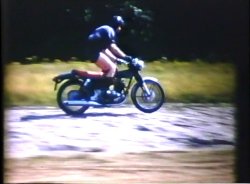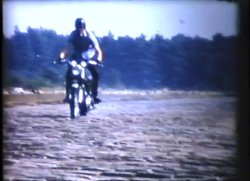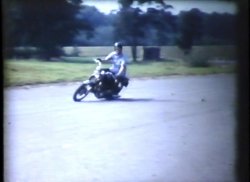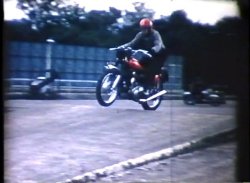Testing Commando Frame
Background
First introduced in 1950, the Featherbed frame was to become the basis of Norton's range of motorcycles, having been impressed by the superior handling of the lighter, swinging arm design of Rex McCandless compared to their ealier plunger frame, nicknamed 'the garden gate'.
.jpg)
Comprising twin parallel rectangular loops, each formed from a single length of Reynolds steel tubing, with crossed-over welded ends meeting a heavily braced headstock at the front, and swinging arm mountings at the rear, the Featherbed frame proved to be extremely strong for its weight and resistant to all road/transmission stresses.
Unfortunately, over the subsequent years as engine capacities and compression ratios inched ever higher, vibration levels that were not previously a great problem became pronounces to such a degree that it was threatening the saleablity of Norton's range of large twin-engined bikes
Following the restructuring of AMC into Norton-Villiers Ltd in1966, when a new Norton model was urgently required, former Rolls-Royce engineer Dr Stefan G Bauer was called in to analyse the vibration problem and came to the conclusion that a radically different approach to the frame design was required.
.jpg)
Abandoning the box frame approach, he substituted a single large diameter, thin walled (2¼" x 16 swg) top tube that ran from the top of the steering tube to the seat struts. A short, angled gusset, made from the same size tube, was incorporated to triangulate the steering/top tube connection.
Two smaller diameter tubes (1" x 14 swg) splayed out from the bottom of the steering tube, running underneath the engine/gearbox, where they were connected by a centre stand mounting tube, then curving upwards to meet the seat struts at the rear suspension top fixing brackets.
Triangulation of the rear section of the frame was achieved by a further two tubes of the same material, which ran from the rear engine/gearbox mounting bracket to midway along the large top tube.
This arrangement was intended give a lightweight frame with a high resistance to twisting.
You can read more about Dr Bauer's thoughts on motorcycle frame design in this
1967 'Motor Cycle' article.
(courtesy Norton Owners Club Roadholder magazine No 365 May 2018)
.jpg)
When the resulting Norton Commando model was launched in 1967, the combination of its completely new frame and the 'isolastic' engine-transmission
mounting system (conceived by development engineers Bernard Hooper and Bob Trigg) had the desired effect of finally taming the inherent vibration problem
associated with big twin bikes.
You can read 'Birth of the Norton Commando' article on the Links page.
(courtesy Classic Bike Guide magazine - June 2018)
The press lavished praise on the revolutionary concept, describing it as the "Aston-Martin of motor cycles" and, not only did the team receive the 1969 Ferodo award for the most meritorious contribution to motorcycling, but the model itself also won the Motor Cycle News 'Machine of the Year' award for five successive years, between 1968 and 1972.
A feat never achieved before, or since, by any marque!
Problems
.jpg)
Although the Commando got off to a good, almost euphoric start, there shortly emerged doubts as to the robustness of its frame.
Reports started coming back from America, via the Berliner Corporation (the New Jersey-based Norton importers), that there had been five fatal accidents with Commandos as a result of frame breakages, where the twin down tubes joined the head stock and in the main backbone, just behind the bracing gusset.
As a consequence of these frame failures, the relevant U.S. authorities were threatening to impose an import ban on the bike unless remedial action could be taken, an action that would have had a huge financial impact on the firm as well as reputation of the Norton name.
Initial investigation into the accidents uncovered that the Commando bikes involved had been ridden extensively off-road or in the desert, an environment that they had never been designed for.
(It was also mooted that the failures may have been initiated when the bikes were being transported to the various dealers, as it had been reported that some of the crated-up machines had been deliberately dropped off of the back of the delivery vehicle to strike the ground at their front end, possibly causing impact damage.)
But this didn't provide a sufficient argument against the pending import ban, so a frame modification to strengthen up the problem area was urgently sought.
Both the Featherbed and Commando frames had been built at the Renolds Tube Company in Birmingham but, in the latter case, all the initial design work had been carried out by the Norton Villiers design team without availing themselves of Renolds' specialist experience.
However, following the breakages, the manufacturer's metallurgists were asked to carry out inspections on several of the returned frames in order to identify possible causes of the fractures, ruling out both welding and material failure.
This left practical testing as the only means of identifying the likely causes.
Testing
The starting point of the investigation was to carry out extreme condition testing of the current Commando frame to try to replicate the frame breakages as found in America and, to this end, the Ministry of Defence (MOD) tank testing facility at Chobham, Surrey was utilised.
Four of AMC's team of test riders, Alan Jones, Bill Brooker, Neil Collett and Nick Hyde were co-opted to ride the bikes over a punishing range of surfaces in an effort to identify any frame weaknesses.
Over a period of six weeks, the team of testers would ride their respective bikes from Plumstead to the MOD site, usually taking less than 30 minutes. This was in the days before the M25, or any other motorways, which shows how incredible the riders were as well as how fast and great handling a bike the Commando was!
In order to try to replicate the frame breakages that occurred in the States, the bikes would be ridden along the equivalent of Belgian pavé roads, along a railway track (over the sleepers), as well as perform over 3000 jumps from various ramps!
Filmed evidence of this brutal testing was taken by Alan Jones - some whilst riding pillion on another Commando alongside the test track - which, after being viewed by the relevant American authorities, was sufficient for them to lift their threatened import ban.
You can view short clips from this filming by clicking on the following images.
(Note that these images have undergone a series of media transferrals since their original 8mm film format - to videotape, DVD and now wmv for the internet - so the quality is somewhat lower than usual, but still remarkably good).




You can also view the full video (13:57) on YouTube.
It was quite obvious that serious injury could result following the breaking away of the steering tube from the frame and Alan soon realised that, when he heard his own frame break, the worst thing to do was to shut off the motor, as the bike would just fall over and cause a lot of damage to himself.
Such was the severe nature of the test programme that it was quite usual for members of the test team to return back to Plumstead with their legs bleeding, through the repetitive violent contact of their knees with the petrol tanks whilst negotiating the many obstacles.
As it was, only one hospitalisation resulted from the test programme and that was as a result of Bill Brooker landing, after a mid-air leap, onto his petrol tank instead of the seat (bringing more than tears to his eyes!!)
Following on from the testing of the original frame design, other versions with alternative, thicker wall top tubes and gusset were subjected to the same cycle of rigorous punishment, with various improvements in life before breakage.
.jpg)
.jpg)
As well as the modifications proposed by the Norton Villiers design team, Renolds' own motorcycle specialist, Ken Sprayson, put forward his own suggestion to alleviate the frame breakage problem.
His idea involved replacing the existing head tube gusset with an extra small diameter tube, welded to the lower end of the head tube and running horizontally to meet the top tube at the junction with the two rear triangulation tubes.
At the same time, the attachment points for the top engine steady and petrol tank mounting brackets were transferred from the top tube and down tubes respectively and repositioned on the new bracing tube.
Subsequent testing on the Chobham proving ground was to show the superiority of Ken Sprayson's solution, which is summed up in his own words after witnessing the testing:
'The outcome was conclusive - the original design only completed 23 laps before failure occurred.
The best of the heavier top tubes managed 120 laps, whilst my modified design did over 400 laps with no problem.
The modified frame was also subjected to the scrambles course, again without failure......'
(extract from 'Ken Sprayson - The Frame Man'
This design then became the basis of all subsequent Commando frames, giving trouble-free lives to all the various versions of the model that were built over the following years.
Whilst praise must go to Ken Sprayson for his modification, the largest accolade is surely deserved by the team of test riders who, literally, risked their lives for the benefit of the firm they worked for. By carrying out the testing in conditions that no other riders, however bike-hardened, would ever contemplate, they showed that their work was nothing like the 'glory' job that others might have thought it was!